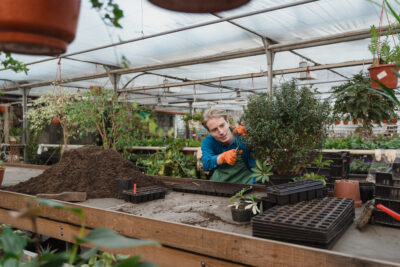
Succulent Care: Watering Frequency & Best Practices for Healthy Plants

Succulents have become increasingly popular in recent years, both as indoor plants and in outdoor gardens. These plants are known for their unique and eye-catching shapes and colors, as well as their ability to store water in their thick leaves and stems. While they are often praised for being low-maintenance, proper succulent care is essential to ensure the health and longevity of these plants.
We will delve into the topic of succulent care, specifically focusing on watering frequency and best practices. We will discuss how to determine the right amount of water for your succulents, the importance of well-draining soil, and the signs of overwatering and underwatering. Additionally, we will provide tips on watering techniques, such as the soak and dry method, and explore other factors that can affect the watering needs of succulents, such as sunlight and temperature. By the end of this article, you will have a comprehensive understanding of how to effectively water and care for your succulents, ensuring their health and beauty for years to come.
- Water your succulents only when the soil is completely dry
- Use a well-draining soil mix to prevent overwatering
- Avoid watering the leaves of succulents, as this can lead to rot
- Provide adequate sunlight for your succulents to promote healthy growth
- Rotate your succulents regularly to ensure even growth
- Avoid using too much fertilizer, as this can damage the roots of succulents
- Monitor the temperature and humidity levels to create optimal conditions for succulents
- Prune your succulents to remove dead or damaged parts and promote new growth
- Be cautious of pests, such as mealybugs and aphids, and take appropriate measures to control them
- Avoid overcrowding your succulents and provide enough space for each plant to thrive
- Frequently Asked Questions
Water your succulents only when the soil is completely dry
Why is watering frequency important for succulent care?
Proper watering is essential for the health and well-being of your succulent plants. Succulents have adapted to survive in arid environments by storing water in their leaves, stems, and roots. Overwatering can lead to root rot and other fungal diseases, while underwatering can cause the plant to become dehydrated and wilted. Finding the right balance is key to keeping your succulents thriving.
How often should you water your succulents?
The frequency of watering your succulents depends on various factors such as the climate, time of year, and the type of succulent. As a general rule of thumb, it is best to water your succulents only when the soil is completely dry. This ensures that the roots do not sit in water, preventing root rot.
Signs that your succulents need water
- Wrinkled or shriveled leaves: When succulents lack water, their leaves may start to appear wrinkled or shriveled. This is a clear indication that it's time to water your plants.
- Leaves losing their plumpness: If the leaves of your succulents start to lose their firmness and become limp, it's a sign that they are in need of hydration.
- Slow growth or wilting: Succulents that are not getting enough water may show signs of stunted growth or wilting.
Best practices for watering succulents
- Use the soak and dry method: This method involves thoroughly watering the soil until water drains out of the bottom of the pot. Allow the soil to completely dry out before watering again.
- Avoid misting or spraying: Succulents prefer to be watered at the root level rather than having their leaves sprayed. Misting can lead to fungal diseases.
- Choose well-draining soil: Succulents thrive in well-draining soil that allows excess water to drain away quickly. Consider using a cactus or succulent-specific potting mix.
- Be mindful of the season: Succulents have different water requirements during different seasons. They may need less water during winter when they are in a dormant phase.
By following these watering practices and paying attention to your succulents' specific needs, you can ensure that your plants stay healthy and vibrant for years to come.
Use a well-draining soil mix to prevent overwatering
 Cacti and Succulents: Understanding Their Unique Watering Requirements
Cacti and Succulents: Understanding Their Unique Watering RequirementsWhen it comes to succulent care, one of the most important factors to consider is the type of soil you use. Succulents thrive in well-draining soil that allows excess water to flow out easily. This is crucial because overwatering is one of the most common mistakes made by succulent owners, often leading to root rot and ultimately the death of the plant.
To ensure your succulents receive the right amount of water, it is recommended to use a well-draining soil mix. This can be achieved by combining equal parts of regular potting soil, perlite, and coarse sand. The potting soil provides the necessary nutrients, while perlite and coarse sand help improve drainage.
Remember, succulents are adapted to survive in arid conditions, where water is scarce. Their roots are not designed to withstand excessive moisture, so using a well-draining soil mix is essential to mimic their natural habitat and prevent waterlogged roots.
Signs of overwatering
Understanding the signs of overwatering is crucial for succulent care. By recognizing these signs early on, you can take immediate action to save your plants. Some common signs of overwatering include:
- Yellowing or wilting leaves: When succulents receive too much water, their leaves may become soft and appear yellow or translucent. This is a sign that the roots are not able to absorb the excess moisture, causing the leaves to become weak and eventually wilt.
- Root rot: Overwatering can lead to root rot, which can be identified by a foul odor and dark, mushy roots. If left untreated, root rot can quickly spread and cause irreversible damage to your succulent.
- Mold or fungus: Excessive moisture can create a favorable environment for mold or fungus to grow. If you notice any fuzzy growth or unusual spots on your succulent, it could be a sign of overwatering.
If you observe any of these signs, it is important to adjust your watering routine immediately. Allow the soil to dry out completely before watering again, and consider repotting your succulent using a well-draining soil mix.
Best watering practices for succulents
Now that you understand the importance of using a well-draining soil mix and the signs of overwatering, let's discuss some best watering practices for succulents:
- Water thoroughly but infrequently: Instead of lightly sprinkling water on your succulent, it is recommended to water them thoroughly until water drains out from the bottom of the pot. However, it is important to allow the soil to dry out completely between waterings to prevent overwatering.
- Water at the base: Avoid watering the leaves of your succulent as it can lead to rot. Instead, direct the water towards the base of the plant, allowing the roots to absorb the moisture.
- Water based on the season: Succulents have different water requirements depending on the season. During the active growing season (spring and summer), they may need more frequent watering. However, during the dormant period (fall and winter), they require less water as their growth slows down.
- Monitor the moisture level: Use a moisture meter or stick your finger about an inch into the soil to check its moisture level before watering. If the soil feels dry, it's time to water your succulent. If it's still moist, wait a few more days.
By following these watering practices and using a well-draining soil mix, you can ensure the health and longevity of your succulents. Remember, it's always better to underwater than overwater when it comes to succulent care.
 Discover the Perfect Succulent Soil at Lowe's - Your Go-To Destination
Discover the Perfect Succulent Soil at Lowe's - Your Go-To DestinationAvoid watering the leaves of succulents, as this can lead to rot
To maintain the health of your succulents, it is crucial to understand proper watering practices. One common mistake many succulent owners make is watering the leaves of their plants. This can actually lead to rot and damage the plant.
When it comes to watering your succulents, it is important to focus on the soil rather than the leaves. Succulents have specialized structures, such as thick leaves and stems, which allow them to store water. Watering the leaves directly can cause them to become waterlogged, leading to root rot and ultimately killing the plant.
Instead, aim to water the soil around the base of the succulent. This will allow the roots to absorb the water as needed. A good rule of thumb is to thoroughly water the soil until it is evenly moist, but not soggy. Remember, succulents are adapted to survive in dry conditions, so it is better to underwater than overwater.
It is also important to consider the frequency of watering. Unlike many other houseplants, succulents prefer to dry out between waterings. Overwatering can lead to root rot and other issues, so it is crucial to allow the soil to dry out completely before watering again.
Best Practices for Watering Succulents
- Use well-draining soil: Succulents thrive in soil that allows excess water to flow out easily. Consider using a well-draining soil mix specifically formulated for succulents or add perlite or sand to improve drainage.
- Water deeply: When watering, make sure to thoroughly saturate the soil. This will encourage the succulent's roots to grow deep into the soil, promoting a stronger and healthier plant.
- Water less frequently: Succulents are drought-tolerant and prefer to be underwatered rather than overwatered. Allow the soil to dry out completely before watering again. The frequency of watering will depend on various factors such as climate, humidity, and the size of the pot.
- Water in the morning: It is best to water your succulents in the morning to allow any excess moisture to evaporate during the day. This helps prevent the risk of fungal diseases and encourages healthy growth.
- Adjust watering during different seasons: Succulents have different growth patterns throughout the year. During the active growing season, they may require more frequent watering, while in the dormant season, they need less water. Monitor your succulents closely and adjust your watering schedule accordingly.
By following these best practices, you can ensure that your succulents receive the right amount of water and thrive in a healthy environment. Remember, it is always better to underwater than overwater when it comes to succulents.
Provide adequate sunlight for your succulents to promote healthy growth
Succulents are known for their ability to thrive in bright, sunny conditions. To ensure the health and growth of your succulents, it is important to provide them with adequate sunlight.
Place your succulents in an area that receives at least 6 hours of direct sunlight per day. This can be achieved by positioning them near a south-facing window or placing them outdoors in a sunny spot.
 The Importance of Watering Succulents After Repotting
The Importance of Watering Succulents After RepottingHowever, be cautious not to expose your succulents to too much direct sunlight, especially during the hot summer months. Excessive sun exposure can lead to sunburn and damage the leaves of your succulents. In such cases, it is recommended to provide them with partial shade or use a sheer curtain to filter the sunlight.
Remember to rotate your succulents every few weeks to ensure even exposure to sunlight. This will prevent them from leaning towards the light source and promote even growth.
Watering frequency for succulents
One of the most crucial aspects of succulent care is getting the watering frequency right. Unlike many other plants, succulents have unique water storage capabilities that allow them to survive in arid conditions.
As a general rule of thumb, succulents should be watered deeply but infrequently. Overwatering is a common mistake that can lead to root rot and the death of your succulents.
Instead, allow the soil to dry out completely between waterings. This can be easily determined by sticking your finger about an inch into the soil. If it feels dry at that depth, it's time to water your succulents.
Remember, it is better to underwater your succulents than to overwater them. Succulents are adapted to surviving in drought-like conditions, so they can tolerate periods of dryness.
Best practices for watering succulents
When it comes to watering succulents, it is important to follow these best practices:
 How Often Should Succulent Plants be Watered?
How Often Should Succulent Plants be Watered?- Use well-draining soil: Succulents thrive in soil that allows excess water to drain quickly. Make sure to use a well-draining potting mix specifically formulated for succulents or add perlite or coarse sand to improve drainage.
- Water at the base: Avoid watering the leaves of your succulents as this can lead to rot. Instead, direct the water towards the base of the plant, soaking the soil thoroughly.
- Water in the morning: Watering your succulents in the morning allows excess moisture to evaporate during the day, reducing the risk of fungal diseases.
- Avoid standing water: Ensure that the water doesn't accumulate in the saucer or tray beneath your succulent pot. Standing water can cause root rot, so always empty any excess water after watering.
By following these watering practices, you will help your succulents thrive and maintain their vibrant beauty.
Rotate your succulents regularly to ensure even growth
One important aspect of succulent care is to regularly rotate your plants. This simple practice helps promote even growth and prevents your succulents from leaning or stretching towards one direction.
Rotating your succulents allows all sides of the plant to receive an equal amount of sunlight. Sunlight is crucial for succulents as they require bright, indirect light to thrive. By rotating them, you ensure that each side of the plant gets its fair share of sunlight, resulting in a more balanced and symmetrical growth.
How often should you rotate your succulents?
The frequency of rotation largely depends on the growth pattern of your succulents and the direction of the light source. As a general rule of thumb, you should aim to rotate your succulents once every two weeks. However, if you notice that your plants are leaning towards a particular direction or stretching towards the light, you may need to rotate them more frequently.
How to rotate your succulents?
 Top vs. Bottom: The Best Way to Water Succulents for Optimal Growth
Top vs. Bottom: The Best Way to Water Succulents for Optimal GrowthWhen rotating your succulents, it's essential to handle them with care to avoid damaging the delicate leaves or roots. Here's a simple step-by-step guide to help you:
- Gently hold the base of the succulent, ensuring a firm grip.
- Slowly turn the plant clockwise or counterclockwise, making a quarter turn.
- Place the succulent back in its original position or choose a new location if desired.
Remember to be gentle while rotating your succulents, especially if they have shallow root systems. Avoid putting excessive pressure on the leaves or stems to prevent any breakage or damage.
Benefits of rotating succulents
- Promotes even growth and prevents leaning or stretching
- Ensures all sides of the plant receive equal sunlight
- Prevents one-sided growth and encourages symmetrical appearance
- Helps maintain overall plant health and vitality
By incorporating regular rotation into your succulent care routine, you can enjoy healthier and more aesthetically pleasing plants. Remember, a little extra effort in rotating your succulents can go a long way in maintaining their beauty and vitality.
Avoid using too much fertilizer, as this can damage the roots of succulents
When it comes to succulent care, one of the most common mistakes that people make is using too much fertilizer. While it is important to provide nutrients to your plants, over-fertilizing can actually be detrimental to their health. This is especially true for the delicate roots of succulents.
Excessive fertilizer can lead to a buildup of salts in the soil, which can harm the roots and prevent the plant from absorbing water properly. This can result in root rot and ultimately lead to the death of your succulent.
Therefore, it is crucial to follow the recommended guidelines for fertilizing succulents. Typically, it is best to use a balanced, water-soluble fertilizer diluted to half or quarter strength. This ensures that your succulents receive the necessary nutrients without overwhelming their sensitive root systems.
 Choosing the Right Soil: The Best Type for Growing Succulents in Pots
Choosing the Right Soil: The Best Type for Growing Succulents in PotsAdditionally, it is important to fertilize your succulents sparingly. During the active growing season, which is usually spring and summer, you can fertilize your succulents every 2-4 weeks. However, during the dormant period, which is typically fall and winter, it is best to refrain from fertilizing altogether.
Remember, when it comes to succulents, less is often more. By practicing proper fertilization techniques, you can help your succulents thrive and avoid potential damage to their delicate roots.
Monitor the temperature and humidity levels to create optimal conditions for succulents
Succulents thrive in specific temperature and humidity conditions, so it's crucial to monitor these factors to ensure their well-being. Maintaining the right environment will help prevent issues such as over or under watering, mold growth, and pest infestations. Here are some best practices to follow:
1. Temperature
Succulents are generally adapted to warm and dry climates, so it's important to keep them in an environment that mimics these conditions. The ideal temperature range for most succulents is between 60°F (15°C) and 80°F (27°C). However, some varieties can tolerate cooler temperatures down to 40°F (4°C) or higher temperatures up to 90°F (32°C). It's essential to research the specific temperature requirements of your succulents to ensure their optimal growth.
2. Humidity
Succulents are known for their ability to store water in their leaves and stems, making them more resilient to dry conditions. Therefore, they prefer low humidity environments. Aim for a humidity level between 30% and 50% to create the perfect atmosphere for your succulents. If the humidity is too high, it can lead to issues like rot or fungal diseases.
3. Air Circulation
Proper air circulation is vital for succulents as it helps prevent the buildup of excess moisture and reduces the risk of fungal diseases. Place your succulents in well-ventilated areas, and if you're growing them indoors, consider using a fan to improve air circulation.
 The Importance of Drain Holes for Succulent Growth and Care
The Importance of Drain Holes for Succulent Growth and Care4. Lighting
Succulents love bright light, but direct sunlight for prolonged periods can cause their leaves to burn. Place your succulents in areas with bright, indirect light, such as near a window or on a balcony. If you notice your succulent stretching or leaning towards the light source, it may be an indication that it's not receiving enough light.
5. Watering Frequency
One of the most crucial aspects of succulent care is getting the watering frequency right. Overwatering is a common mistake that can lead to root rot and other problems. Succulents have adapted to survive in arid environments, so they prefer infrequent but deep watering. A general rule is to water your succulents thoroughly once the top inch of the soil is dry. However, remember that different succulent varieties may have different water requirements, so it's essential to research and understand the needs of your specific plants.
By monitoring the temperature and humidity levels, ensuring proper air circulation, providing adequate lighting, and following the appropriate watering frequency, you can create the optimal conditions for your succulents to thrive. Remember that each succulent variety may have unique care requirements, so always research and adapt your care routine accordingly.
Prune your succulents to remove dead or damaged parts and promote new growth
Pruning your succulents is an essential step in their care routine. It not only helps to remove any dead or damaged parts of the plant but also promotes new growth and ensures the overall health of your succulents.
When pruning your succulents, it is important to use sharp and clean pruning shears or scissors. This helps to prevent any unnecessary damage to the plant and reduces the risk of introducing any infections or diseases.
Start by identifying any dead or brown leaves, stems, or flowers on your succulent. These parts are no longer viable and should be removed. Use your pruning shears to carefully cut them off at the base, making sure to avoid damaging the healthy parts of the plant.
Additionally, if you notice any damaged or rotting parts, it is crucial to remove them as soon as possible. This prevents the spread of disease and helps to maintain the overall health of your succulent.
 Avoiding Overwatering: Essential Tips for Proper Succulent Care
Avoiding Overwatering: Essential Tips for Proper Succulent CareWhile pruning, keep in mind that some succulents have a natural tendency to branch out. If you want to encourage branching, you can prune the top of the plant to stimulate new growth from the sides.
Remember to always prune your succulents during their active growing season, which is typically in spring or summer. During this time, they have the ability to heal and recover more efficiently.
After pruning, it is a good idea to let the cut ends of your succulents dry out for a day or two before replanting them or placing them back in their pots. This helps to prevent any potential rotting or infections.
Overall, regular pruning is a key practice for maintaining healthy and thriving succulents. By removing dead or damaged parts and promoting new growth, you are ensuring the longevity and beauty of your succulent collection.
Be cautious of pests, such as mealybugs and aphids, and take appropriate measures to control them
Pests can be a common problem for succulent plants, with mealybugs and aphids being among the most troublesome. These pesky insects can quickly infest your plants, causing damage and even death if left untreated. It's important to be vigilant in monitoring your succulents for any signs of infestation and take immediate action to control them.
Identifying Mealybugs:
 The Best Way to Water Succulents: Top or Bottom?
The Best Way to Water Succulents: Top or Bottom?- Mealybugs are small, soft-bodied insects that appear as white, cottony masses on the leaves and stems of succulents.
- They feed by sucking sap from the plants, causing wilting, yellowing, and stunted growth.
Identifying Aphids:
- Aphids are tiny, pear-shaped insects that can be green, yellow, black, or brown in color.
- They cluster on the leaves and stems, sucking the sap and causing distortion and discoloration.
Controlling Mealybugs and Aphids:
- Isolate Infected Plants: If you notice any signs of mealybugs or aphids, immediately isolate the infected plants from your other succulents to prevent the spread of the infestation.
- Remove Visible Pests: Use a cotton swab soaked in rubbing alcohol or a mixture of water and dish soap to gently remove any visible pests from the plants. Be sure to target the areas where the pests are concentrated.
- Apply Natural Predators: Introducing natural predators, such as ladybugs or lacewings, can help control the population of mealybugs and aphids. These beneficial insects feed on the pests, reducing their numbers.
- Use Insecticidal Soap: If the infestation is severe, you may need to resort to using insecticidal soap. Spray the affected plants thoroughly, ensuring that the soap reaches all the nooks and crannies where the pests may be hiding.
- Maintain Good Plant Hygiene: Regularly clean the leaves and stems of your succulents to remove any dust or debris that may attract pests. Additionally, avoid overwatering your plants, as excess moisture can create a favorable environment for pests.
By being proactive and taking appropriate measures to control mealybugs and aphids, you can protect your succulents and ensure their overall health and vitality.
Avoid overcrowding your succulents and provide enough space for each plant to thrive
When it comes to succulent care, one of the key factors to consider is providing enough space for each plant to thrive. Overcrowding can lead to poor air circulation and increased competition for resources, which can negatively impact the health of your succulents.
To ensure optimum growth and prevent overcrowding, it is important to space out your succulents adequately. This will not only allow each plant to receive adequate sunlight but also prevent the spread of diseases and pests.
When arranging your succulents, consider their mature size and growth habits. Some succulents tend to spread out, while others grow in a more compact manner. Take this into account and give each plant enough room to grow without interfering with its neighboring succulents.
Additionally, providing enough space between succulents will make it easier for you to access and care for each plant individually. This includes watering, inspecting for pests, and removing any dead or damaged leaves.
 Can Ice Cube Succulents effectively hydrate your plants?
Can Ice Cube Succulents effectively hydrate your plants?Avoiding overcrowding not only promotes healthier plants but also enhances the aesthetic appeal of your succulent display. Each plant will have enough room to showcase its unique foliage and form, creating an eye-catching and harmonious arrangement.
Remember, your succulents are living organisms that require space to thrive, just like any other plant. By giving them the necessary room to grow and breathe, you'll be ensuring their long-term health and vitality.
Frequently Asked Questions
1. How often should I water my succulents?
Generally, succulents should be watered every 1-2 weeks. However, it's important to adjust the frequency based on factors such as the type of succulent, humidity levels, and the climate you live in.
2. How do I know when to water my succulents?
A good rule of thumb is to wait for the soil to completely dry out between waterings. Check the moisture level by sticking your finger about an inch into the soil – if it feels dry, it's time to water. Avoid overwatering, as succulents are prone to root rot.
3. Can I use tap water to water my succulents?
Tap water can be used, but it's best to let it sit out for 24 hours to allow any chlorine and fluoride to dissipate. Alternatively, you can use filtered or distilled water to avoid any potential mineral buildup in the soil.
4. Should I mist my succulents?
Misting is not necessary for most succulents. They prefer deep watering to encourage strong root growth. However, if you live in a dry climate, misting occasionally can provide some extra humidity for your plants.
If you want to read more articles similar to Succulent Care: Watering Frequency & Best Practices for Healthy Plants, you can visit the Watering and Soil category.






You Must Read